Cassiopeia is a well-known constellation that is easily visible in the northern hemisphere. When gazing at the night sky, it’s hard to miss the fascinating arrangement of stars that resemble either the letter W or M. This constellation, Cassiopeia, boasts approximately 90 stars that are brighter than magnitude 6 and can be seen without the aid of a telescope. Spanning an impressive 598 square degrees, Cassiopeia is the 25th largest constellation in terms of area.
It is commonly referred to as Cassiopeia or simply Cas.
The Constellation Cassiopeia in the Celestial Sphere
In the Russian territory, the constellation Cassiopeia remains visible throughout the year and does not set. During the spring and early summer months, it can be observed rising in the eastern part of the sky. It then moves across the zenith and eventually sets in the western direction. In the southern regions, Cassiopeia does not reach as high in the sky and can be found in the northern part.
The distinctive shape of Cassiopeia is formed by the stars ε (Seguin), δ (Rukbach), γ (Navi), α (Shedar), and β (Kaf). These stars have varying brightness levels, ranging from 2.3 m to 2.7 m, with the exception of Seguin, which has a fainter brightness of 3.4 m.
Locating the Cassiopeia constellation in the night sky is a straightforward task due to its striking shape. It can be found in close proximity to the Big Dipper, positioned symmetrically with respect to Polaris. Just below, you will easily spot Capella, the most prominent star in the Ascendant constellation and one of the brightest in the entire sky.
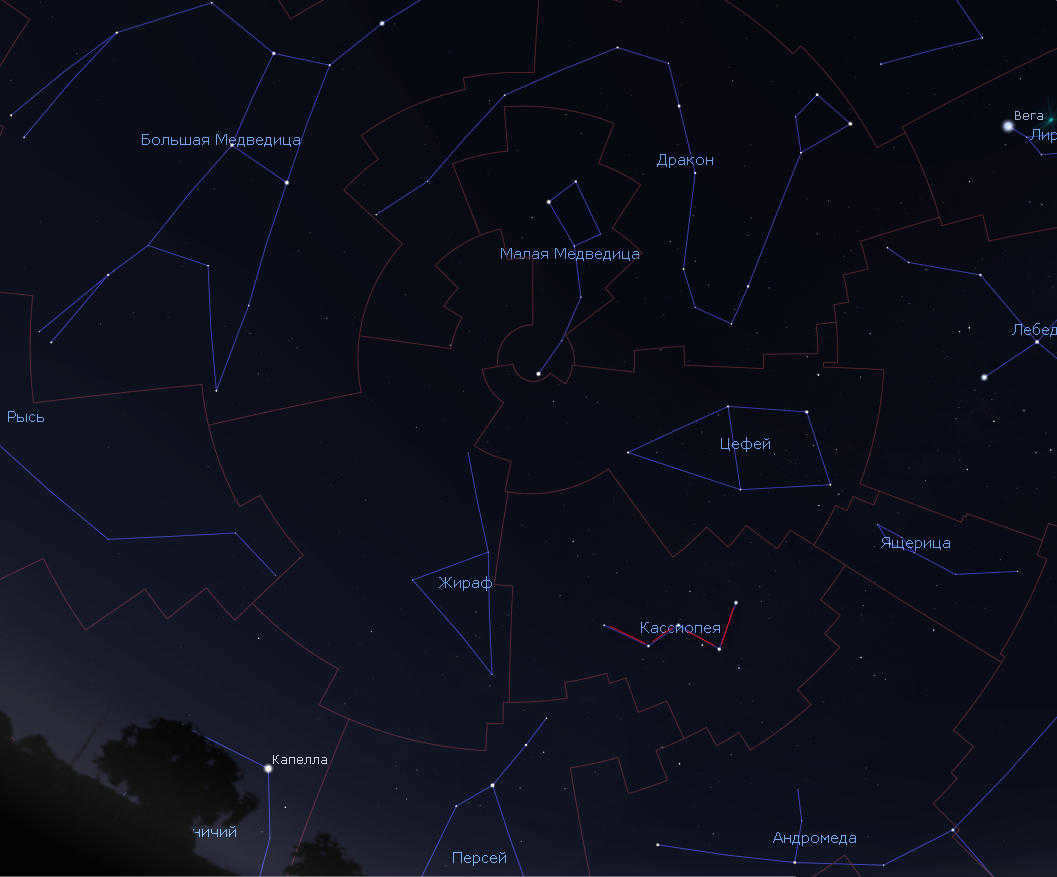
The constellation Cassiopeia can be observed in the night sky. It is located at its highest point when the Big Dipper sinks towards the horizon and vice versa.
If you draw and extend a line along the central part of the Swan constellation, you can also use it to locate Cassiopeia along the path of this line.
Cassiopeia is famous for its figure in the shape of the letter W, which is one of the most noticeable asterisms in the sky.
Below is a diagram illustrating the constellation Cassiopeia, including its brightest stars and other objects:
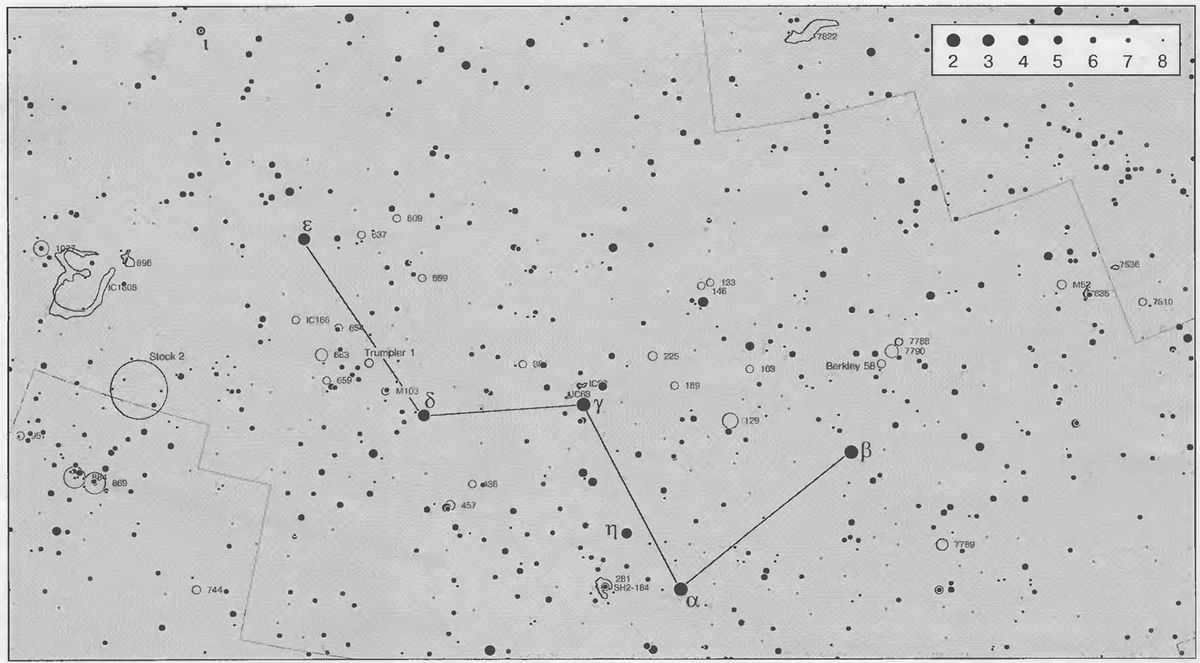
Fascinating entities in the Cassiopeia constellation
In this constellation, there exist numerous intriguing entities that are worth one’s attention. First and foremost, these include the stars that form the shape of Cassiopeia. Additionally, one can find the largest radio source in the sky, Cassiopeia A, several nebulae, dwarf galaxies – which are satellites of the Andromeda Galaxy, and a variety of dispersed star clusters.
Stars in the constellation of Cassiopeia
Each of the primary stars that make up the figure of the Cassiopeia constellation has its own unique name. If we read them from left to right while looking at the W shape, we have Seguin, Rukbach, Navi, Shedar, and Kaf. Among these stars, there are some particularly interesting ones that are worth exploring.
Alpha Cassiopeia – Shedar
Shedar is an orange giant star situated approximately 228 light-years away. In the constellation, it is positioned in the lower right vertex of the W shape. The name Shedar originates from the Arabic word for “breast.” Despite its relatively low brightness of only 2.24 m, Shedar is actually 4-5 times more massive than the Sun and 37 times larger in size. Additionally, it emits 500 times more light. The vast distance at which this massive star is located is truly remarkable.
It is believed that Shedar is a variable star, although it has not been observed since the 19th century. Perhaps it will make an appearance someday.
There is a belief that this star is a binary system consisting of a neutron star. It emits powerful radio waves and is the only one that can be seen with the naked eye.
Kaf is the name of Beta Cassiopeia.
Translated from Arabic, Kaf means “palm”. It is positioned as the rightmost star in the shape of a W and is classified as a subgiant. It is located 47 light-years away from Earth and has an average brightness of +2.28 m in the sky. But why is it considered average?
This is because Kaf is a variable star of the δ Shield type, and it is the brightest star in this category. Its brightness fluctuates between +2.25 m and +2.31 m with a period of 2.5 hours. Although the observation interval is small, it is accurately measured using photometric methods.
Currently, Kaf is undergoing a process of contraction and heating due to internal pressure, as helium synthesis has already ceased. The next phase in the star’s evolution is becoming a giant.
Cassiopeia’s star Navi, known for its gamma-ray emissions.
American astronaut Virgil Ivan Grissom jokingly named this star Navi, which is Ivan spelled backwards and happens to be his middle name. This playful moniker is how the star appears on NASA’s list of celestial bodies. Navi is situated in the heart of the distinctive W constellation and is considered a significant navigational star due to its prominent visibility and simple identification in the night sky.
One of the most fascinating stars in the Cassiopeia constellation is, perhaps, Navi. It displays a range of brightness from 1.60 to 3.0 m, making it an irregular type variable star. The amplitude of its variations is significant, allowing it to be observed with the naked eye or binoculars. There are instances when Navi becomes the brightest star in the constellation, as was the case in 1937. During that time, it seemingly underwent an explosive event, expanding and releasing matter into space.
Navi surpasses the Sun in terms of luminosity, emitting 55000 times more light. It is also 14 times larger in size and 19 times heavier in mass. With a surface temperature exceeding 30,000 K, this hot giant star is located 610 light-years away from our planet.
Through a telescope, approximately 2″ away from Navi, another star with a brightness of 11 m can be observed. This star forms a double star system, although it is not a physical pairing but rather an optical double. Regardless, it is still a sight to behold.
Cassiopeia Delta – Ruckbach
This star, known as Cassiopeia Delta – Ruckbach, is an eclipsing variable star, similar to the well-known Algol. It has a period of approximately 460 days, during which its brightness fluctuates between magnitudes 2.68 and 2.74. The system is comprised of a white giant and a yellow dwarf, which is comparable in size to our own Sun. Located at a distance of nearly 100 light years, Cassiopeia Delta – Ruckbach is an intriguing celestial object to study.
Epsilon of Cassiopeia – Seguin
The Seguin star is located on the far left side of the W-shaped constellation known as Cassiopeia. It does not hold any particular significance, but it is worth noting that this star is relatively young, being only 15 million years old. With a surface temperature of approximately 15,000 K, it is considered to be a hot star. In terms of its physical characteristics, the Seguin star is 9 times more massive than our Sun and 6 times larger in size. Its brightness is measured to be 3.34 m.
Rho Cassiopeia: A Rare and Distant Star
Rho Cassiopeia is an exceptionally unique star that resides unimaginably far from our planet, estimated to be located at a staggering distance of 11-15 thousand light years. Despite its immense distance, when observed from Earth, it appears rather dim with a brightness ranging from 4.1 to 6.2 magnitudes. Nevertheless, locating and identifying this star is an extraordinary feat, as no other star situated at such a vast distance is visible to us at all!
What sets Rho Cassiopeia apart from other stars is its classification as a rare type of yellow hypergiant. In fact, there are only seven stars of this kind in the entire Milky Way galaxy, and interestingly, one of them can also be found in the constellation of Cassiopeia. This specific yellow hypergiant is a mind-boggling 450 times larger than our very own Sun, making our Sun appear no larger than a tiny speck of dust in comparison.
One of the most remarkable characteristics of Rho Cassiopeia is its prodigious light emission, which exceeds that of the Sun by a staggering 550,000 times. This tremendous luminosity is the reason why we are able to perceive and observe this star despite its immense distance. If Rho Cassiopeia were to be located within a range of 20 to 1,000 light years like most other stars, it would undoubtedly be the brightest star visible in the night sky.
It is known to scientists as one of the most brilliant stars in existence. Its luminosity fluctuates due to being a semi-regular variable. Approximately every 50 years, it undergoes a dramatic eruption, expelling a substantial amount of matter. For instance, in the years 2000-2001, it discharged an astonishing 10,000 Earth masses of material into the vastness of space.
It is believed that this particular celestial body has already undergone a supernova explosion, although we have yet to witness it firsthand, as the light emitted from this event takes approximately 11-15 thousand years to reach us.
Additional entities in the constellation Cassiopeia
Cassiopeia is home to several captivating entities that are observable using a modest or moderate-sized amateur telescope with an aperture of 150 mm or less. Among these are 3 planetary nebulae, 4 diffuse nebulae, 7 galaxies, 43 open clusters, and even 1 quasar.
Star clusters in the constellation of Cassiopeia
Situated against the backdrop of the Milky Way, the constellation of Cassiopeia boasts a wealth of galactic objects, including star clusters. While some of these clusters are visible with binoculars, many can be observed with a small telescope. In this article, we will explore some of the most remarkable star clusters in Cassiopeia, although there are dozens more waiting to be discovered.
M 52 (NGC 7654).
This sprawling cluster is situated near the border of the constellations Cassiopeia and Cepheus. With a magnitude of 5 m, it can be easily spotted with binoculars, as several stars are discernible against the luminous backdrop. When viewed through a telescope, the cluster appears as a mesmerizing array of dozens of stars. In fact, it contains approximately 200 stars in total. The appearance of M 52 varies depending on the telescope’s magnification and aperture.
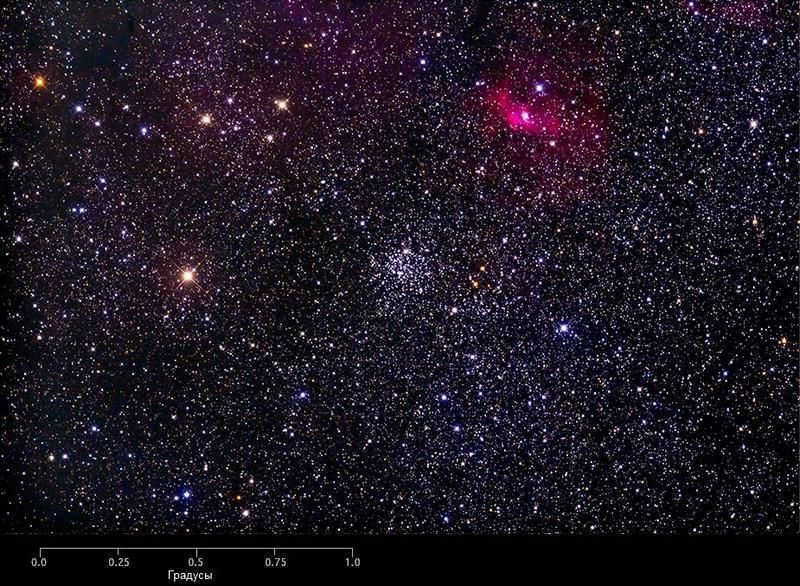
Observed in the night sky is the M 52 cluster and the Bubble Nebula.
An orange star positioned on the outskirts of the cluster, with a brightness of 8.6 m – quadruple, has three additional components that can be seen using a powerful telescope to the south, north, and northeast of the main star.
M 52 is located approximately 5000 light-years away and has a diameter of 24 light-years. It is relatively young, with an estimated age of only 20 million years. Additionally, within the same field of view, the reflecting nebula known as the “Bubble” can also be observed.
NGC 7789
Caroline Herschel made the remarkable discovery of this stunning diffuse cluster back in 1783. It has earned the nickname of the White Rose or Caroline’s Rose due to its unique arrangement of stars, which resemble loops and create shapes reminiscent of flower petals.
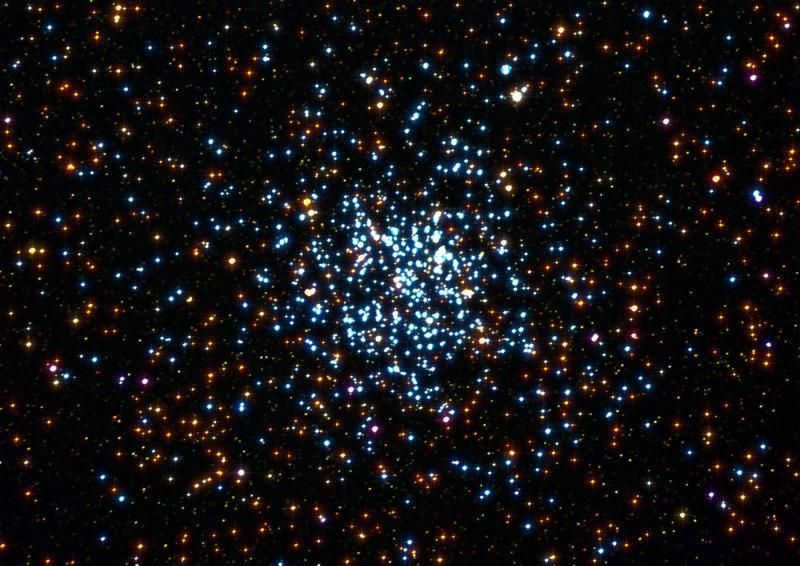
The NGC 7789 is a star cluster that is scattered across the sky.
With a magnitude of 6.7, this cluster can be observed using binoculars, although it is best viewed through a telescope for a more detailed look. Regardless of the telescope’s aperture, the NGC 7789 cluster appears impressive.
NGC 457
The NGC 457 cluster goes by several monikers – Airplane, Alien, Ghost. These names were inspired by the captivating form of this remarkable cluster, which shines with a magnitude of 6.4 and can be observed through binoculars. Interestingly, Messier overlooked this cluster during his time and did not include it in his catalog.
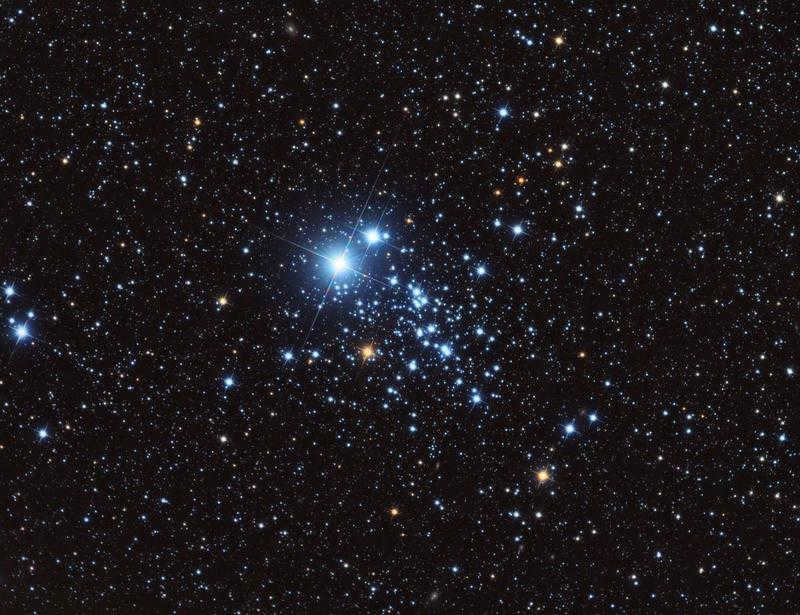
The scattered cluster NGC 457 is a stunning sight when observed with a telescope, making it a must-see for stargazers.
The Nebulae in Cassiopeia
Cassiopeia is home to a variety of captivating nebulae, each with its own unique features.
Cassiopeia A.
Around 300 years ago, a new celestial body emerged in the sky visible from Earth. It is possible that this was the same “noon star” that was documented in 1630. Alternatively, it could have been a supernova that was discovered in 1680 by the astronomer John Flemsteed and had a magnitude of 6 on the sego scale. Regardless, during this time, Earth began to witness the aftermath of a cataclysmic event that occurred in the Milky Way, approximately 11 thousand light-years away – a massive supernova explosion.
The gas, heated to a scorching 30 million degrees, rapidly expanded at a rate of approximately 5 thousand kilometers per second. Presently, we can observe a nebula located 10 light-years away.
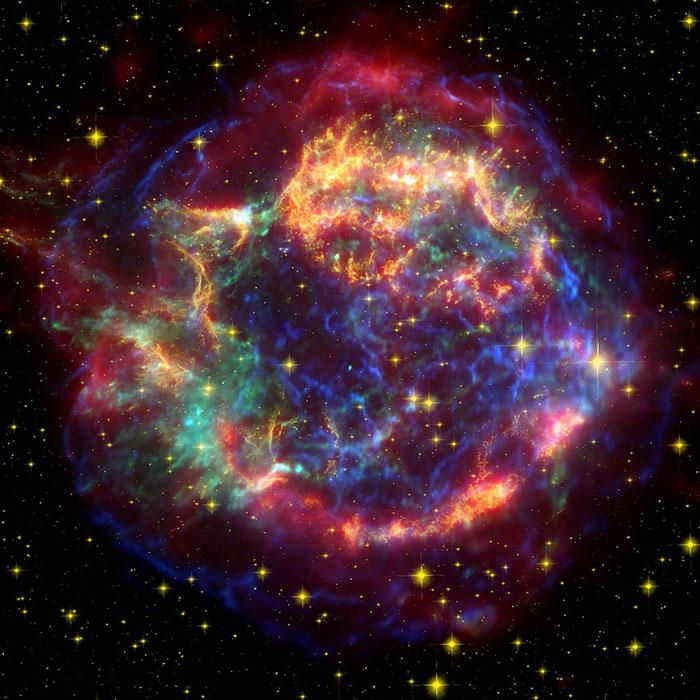
The nebula located where the Cassiopeia A radio source is found.
In the middle of the nebula currently resides a neutron star – the remains of a star that underwent a supernova explosion. This neutron star is one of the most potent radio emitters in our sky, including in the X-ray spectrum. It is known as Cassiopeia A.
Although contemporary scientists were not able to witness the supernova explosion – it happened 300 years ago – they were able to utilize the “Spitzer” space telescope to detect the infrared echo that was reflected from other nearby nebulae. This echo has now reached the Earth. Based on this data, it has been deduced that the nebula was formed by a red giant that collapsed and shed a significant portion of its outer layers. This is an intriguing method of reconstructing past events.
NGC 7635 – The Bubble Nebula
Situated adjacent to the M 52 cluster, the Bubble Nebula is easily observable in the same field of view when using a wide-angle eyepiece and low magnification. It was originally detected by William Herschel in the year 1787.
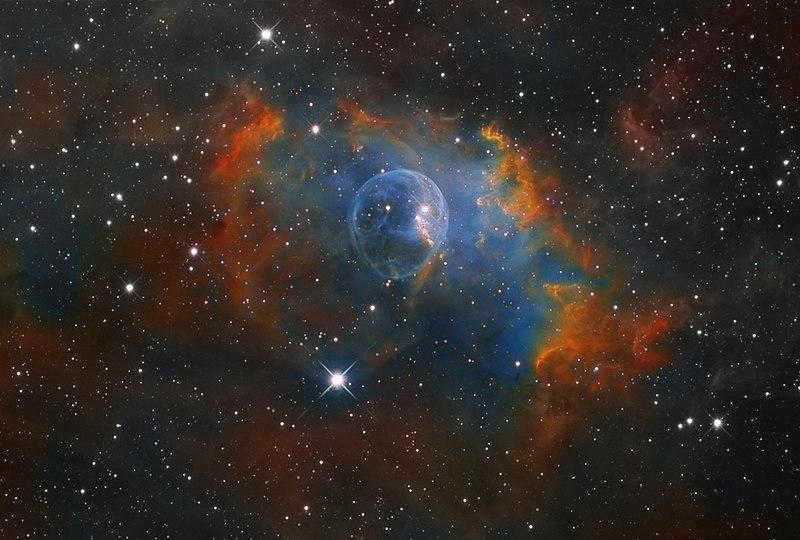
The Bubble Nebula, also known as Nebula NGC 7635, got its name due to its distinctive shape and appearance. This stunning photograph provides a captivating glimpse into the mesmerizing beauty of this celestial object.
Comprising a massive cloud of gas, the nebula is brilliantly illuminated by a nearby star. It is composed of matter that was expelled by the star and subsequently dispersed by the powerful stellar wind, extending over a vast distance in space.
Pacman Nebula – NGC 281
The NGC 281 nebula, also known as the Pacman Nebula, gets its name from its resemblance to the famous video game character. This celestial object was first identified in 1883 by the renowned American astronomer E. E. Barnard.
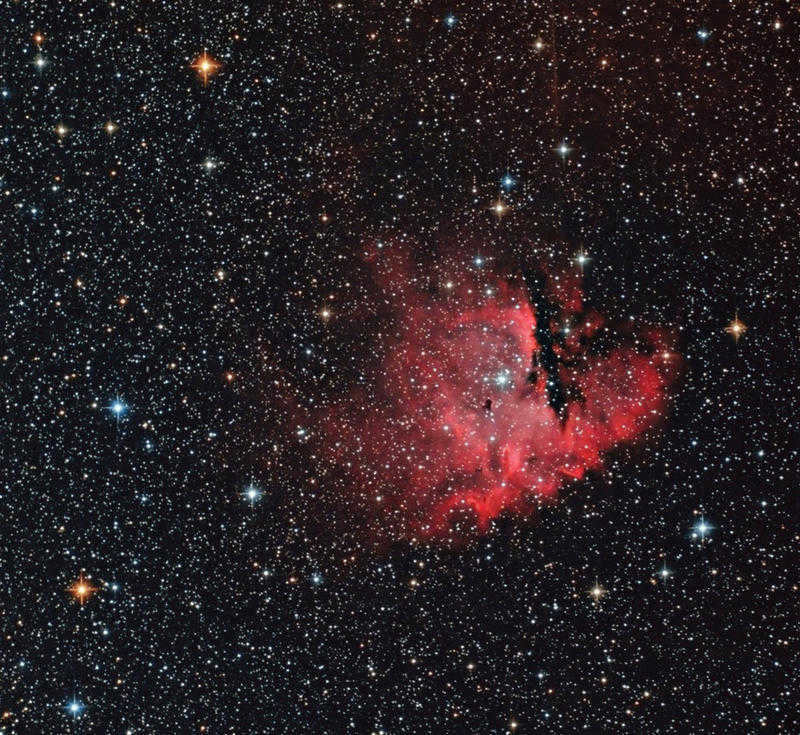
The Pac-Man Nebula, also known as NGC 281, is located approximately 9500 light years away. This massive hydrogen cloud is home to numerous young and hot stars, giving it a brightness of 7.4 m.
The Galaxies of the Cassiopeia Constellation
While there are several galaxies within the Cassiopeia constellation, many of them are intricate objects. A noteworthy pair of galaxies are NGC 185 and NGC 147, which are lesser-known satellites of the renowned Andromeda galaxy. Despite appearing as ethereal clouds even through a powerful telescope, they can still be observed with a smaller telescope. For optimal viewing or photography, it is recommended to use a telescope with an aperture of at least 6-8 inches.
Legend of the Cassiopeia Constellation
There exists a myth surrounding the Cassiopeia constellation. This constellation was named after the wife of Cepheus, the king of Ethiopia. According to the legend, one day Cassiopeia boasted about her beauty, claiming to be more beautiful than the sea nymphs, known as the nerids. Offended by her arrogance, the nerids approached the sea lord Poseidon and requested him to punish Queen Cassiopeia. Poseidon, unable to refuse due to his wife Amphitrite being one of the nerids, sent a sea monster named Cetus to wreak havoc upon Cepheus’ kingdom of Ethiopia.
Cepheus visited the oracle and inquired about the necessary steps to eliminate the sea creature. The oracle’s counsel was to offer his daughter, the stunning Andromeda, as a sacrifice to the monster. The recommendation was carried out accordingly. Andromeda was securely fastened to a boulder above the ocean, but her rescue was undertaken by Perseus, who triumphed over the formidable beast in an unequal clash and subsequently wed the enchanting maiden.
However, the tale does not conclude there. A certain Phineus arrived at the nuptial ceremony and alleged that Andromeda had been unfaithful to him, asserting that only he possessed the rightful claim to her hand in marriage. Perseus engaged in combat with him as well, although he had to employ “heavy artillery” in the form of the Gorgon Medusa’s severed head, which possesses the power to petrify those who gaze upon it. Unfortunately, Cepheus and Cassiopeia were also transformed into statues of stone during the duel, along with numerous other attendees.
Afterwards, by his power, Poseidon placed Cepheus and Cassiopeia in the sky. However, as a punishment for her arrogance, she was suspended upside down for a period of six months.
As can be observed, even in ancient times, weddings were occasions for amusement and enjoyment.
Cassiopeia happens to be one of the constellations visible in the northern hemisphere. Its name is derived from the ancient Greek queen who was notorious for her excessive pride and self-importance. It was documented by Ptolemy in the second century. Further details regarding the appearance of the Cassiopeia constellation and its constituent objects will be covered in this article.
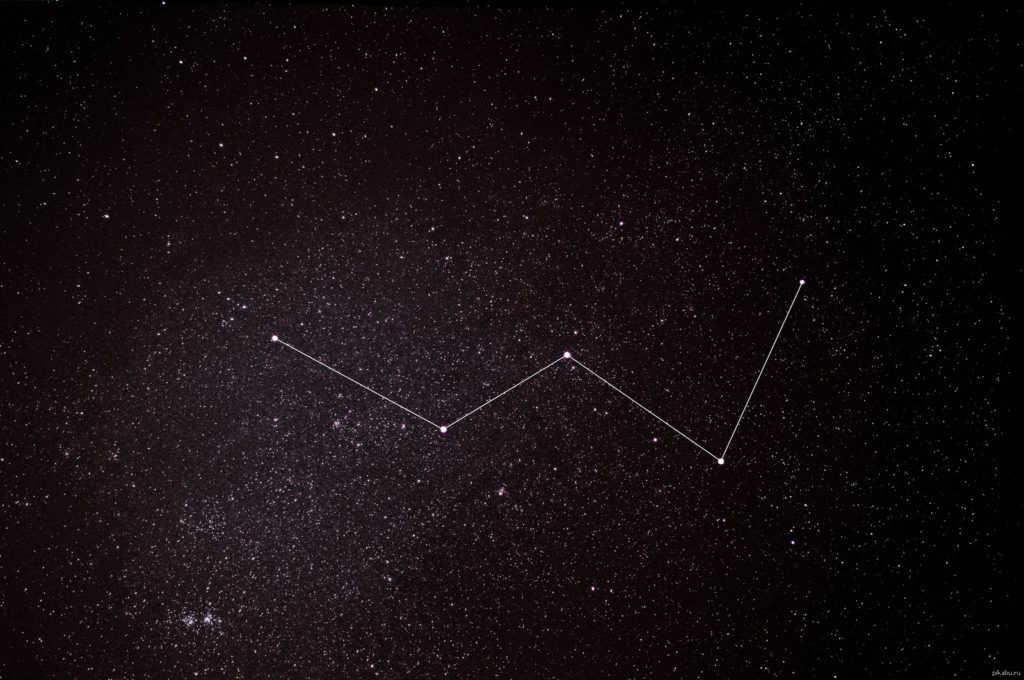
How to identify the appearance of the Cassiopeia constellation and locate it in the night sky
Throughout the year, in the northern hemisphere, one can easily spot Cassiopeia due to its distinctive arrangement of five stars that form a conspicuous letter shape. During the spring and summer seasons, it resembles the letter “W,” while in the fall and winter months, it appears inverted and resembles the letter “M.” To locate Cassiopeia in the night sky, one can follow this method. By drawing an imaginary straight line connecting the stars of the Big Dipper with Polaris, Cassiopeia can be found along this line, with Polaris serving as the center of symmetry.
Cassiopeia covers a vast expanse in the celestial sphere, owing to the abundance of stars within this constellation. With approximately 90 stars boasting a magnitude greater than six, they are easily discernible to the unaided eye.
Stars in the constellation Cassiopeia
The stars located at the corners of the Cassiopeia constellation are named Seguin, Rukbach, Navi, Shedar, and Kaf. These star designations align with the pattern formed by the stars resembling the letter W when viewed from left to right.
The first star in the Cassiopeia constellation is known as Shedar
Translated from Arabic, its name means “breast.” Shedar is situated at a distance of 228 light years away from our Sun. This particular star is classified as an orange giant and possesses the following characteristics:
- Mass – 4 to 5 times the mass of our Sun.
- Diameter – Shedar is approximately 37 times larger than our Sun, although visual observations may not depict this accurately due to its great distance. Similarly, its emitted light cannot be easily observed.
- Luminosity – Shedar has a luminosity that is 676 times greater than our Sun.
- Brightness – It has a star magnitude of 2.24.
- Temperature – Shedar has a temperature of 4,530 degrees Kelvin.
- Age – Estimated to be within the range of 100 to 200 million years.

Shedar can be found in the upper right corner of the constellation Cassiopeia. It emits a greater amount of light than our Sun, yet it has a cooler temperature.
Researchers believe that Shedar may be a star that varies in brightness, although astronomers have not observed any fluctuations over the past hundred years. Its luminosity has remained constant.
Kaf, the Beta Star of Cassiopeia
Kaf is the Arabic term for “palm,” and it refers to the star located in the upper right corner of the letter “W” in the constellation of Cassiopeia. This star, also known as Cassiopeiae Beta, is situated approximately 47 light-years away from our solar system. Kaf possesses the following distinct characteristics:
- Mass – 1.89-1.93 times the mass of the Sun.
- Diameter – 3.5 times larger than the Sun.
- Luminosity – 27.3 times brighter than the Sun.
- Brightness – Approximately 2.28 stellar magnitude. However, as a variable star, its brightness can range from 2.25 to 2.31 stellar magnitude.
- Temperature – 7079 degrees Kelvin.
- Age – Estimated to be between 1.09 and 1.18 billion years old.
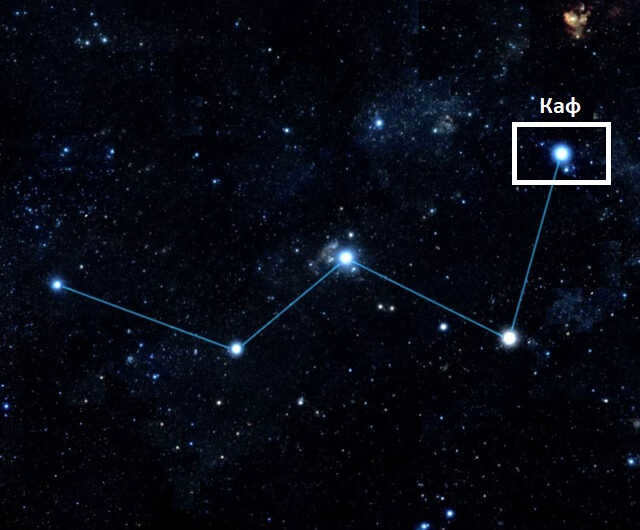
At present, the star is classified as a white subgiant; however, it is currently experiencing a notable transformation. This modification specifically affects the core, which is undergoing a rapid increase in temperature while simultaneously undergoing significant contraction. Once these alterations come to a halt, the white subgiant will transition into a red giant.
Gamma Cassiopeia – Navi
The story behind the star’s name, bestowed upon it by American astronaut Virgil Ivan Grissom, is quite fascinating. If you take a moment to read his middle name, spelled in English from right to left, you’ll find everything becomes clear (IVAN).

Navi, the blue variable star, is the brightest star in the constellation Cassiopeia. It is positioned at the center of the letter “W”. Navi belongs to the category of new-like stars with varying brightness, which has transitioned from a magnitude of 1.6 to a magnitude of 3.0. This change in brightness is attributed to the star’s high rotational speed. When Navi reaches its maximum brightness, it can be observed with the naked eye. Additionally, the gamma ray emissions from Cassiopeia have been detected. Here are the key characteristics of Navi:
- Mass – 19 times the mass of the Sun.
- Diameter – 14 times the diameter of the Sun.
- Luminosity – approximately 55,000 times the luminosity of the Sun.
- Brightness – ranging from 1.6 to 3.0 in star magnitude.
- The temperature of Rukbah is above 30000 °K, which does not have any impact on the objects within our solar system, as this star is located 610 light years away from us.
- The age of Rukbah is 8 million years.
Delta Cassiopeia – Rukbach
The name Rukbah is derived from the Arabic word for knee. Rukbah is the second variable star in the constellation Cassiopeia. The change in brightness of Rukbah is due to the fact that it is a double star composed of a yellow dwarf and a white giant. Delta Cassiopeia, the fourth brightest star in the constellation, possesses the following characteristics.
- The mass of Rukbah is 3.3 times that of the Sun.
- The diameter of Rukbah is 4 times that of the Sun.
- The luminosity of Rukbah is 69 times that of the Sun.
- The brightness of Rukbah ranges from 1.6 to 3 stellar magnitudes.
- The temperature of Rukbah is approximately 8500°K.
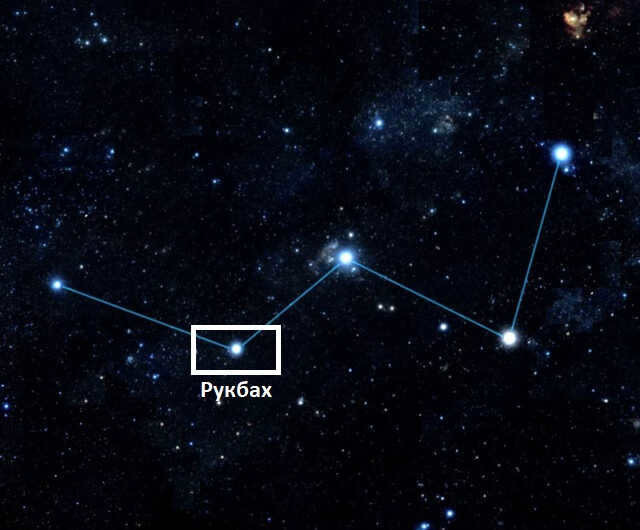
According to certain sources, Delta Cassiopeia is known as Xora.
Epsilon of Cassiopeia – Seguin
Seguin, a giant star with a blue-white color, can be found at the far left point of the letter “W”. This particular star in the Cassiopeia constellation is relatively young, with an estimated age of approximately 15 million years. Seguin possesses distinct stellar characteristics.
- It has a mass of 9 times that of the Sun.
- Its diameter is 6 times larger than that of the Sun.
- It has a luminosity 2500 times greater than that of the Sun, making it a blue-white giant.
- With a brightness of 3.4 star magnitudes, it stands out as one of the brightest stars in the Cassiopeia constellation.
- The temperature of Seguin is approximately 14900°C.
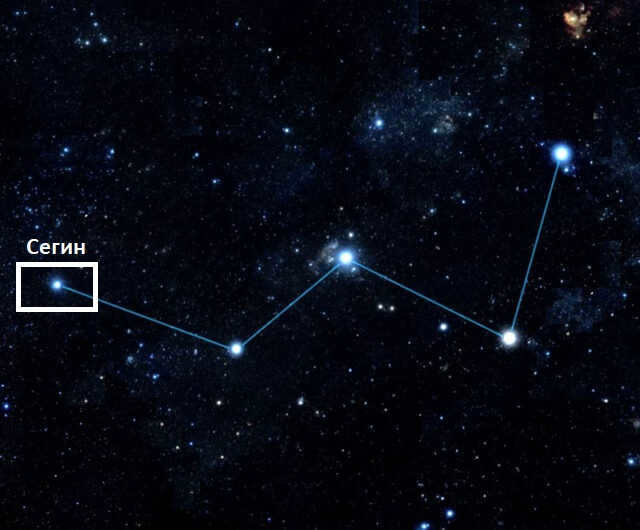
Rho Cassiopeia, situated at a distance of 140 parsecs (460 light years) from the solar system, is an extraordinary star.
Rho Cassiopeia – an uncommon star
Rho Cassiopeia is an exceptional yellow hypergiant that surpasses the size of our Sun. With a radius approximately 450-500 times that of the Sun, this star emits a luminous flux equivalent to that of 550 thousand suns. In the night sky, it appears as a faint variable star due to its estimated distance of 11000 to 15000 light years. Rho Cassiopeia exhibits the following characteristics:
- Mass – 40 times that of the Sun.
- Diameter – 450 times larger than the Sun, equivalent to approximately 630 million kilometers.
- Luminosity – 550000 times greater than the Sun’s luminosity.
- Brightness ranges from 4 to 6 star magnitudes.
- Temperature ranges from 6780 to 7500 °K.
This particular hypergiant stands out not only for its exceptional mass and size, but also for being among the top seven brightest stars in our galaxy.
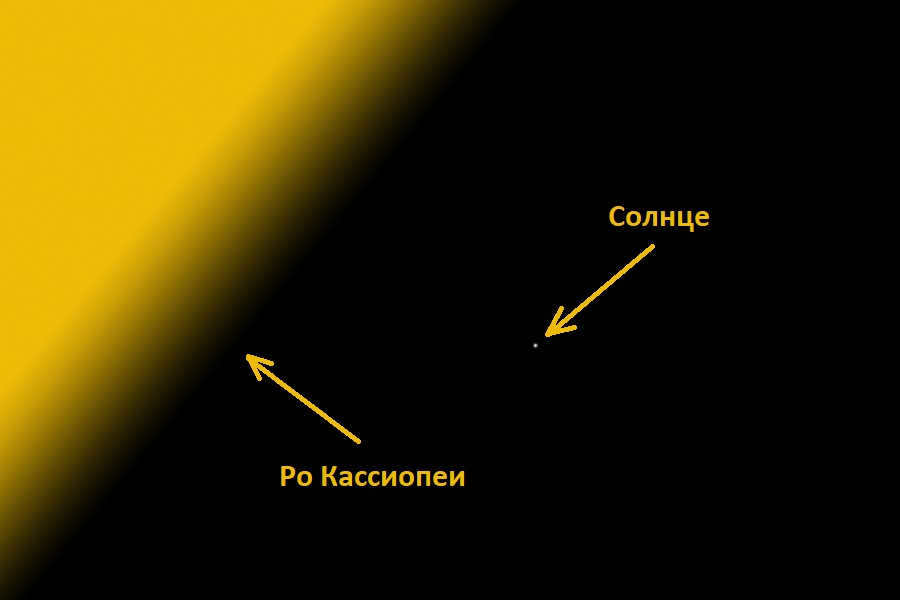
The brightness of Rho Cassiopeia is in a constant state of flux due to its nature as a variable star. It undergoes periodic powerful flares, accompanied by the ejection of stellar matter. During its most recent outburst in 2000-2001, an immense amount of matter was expelled into space, surpassing the Earth’s mass by a factor of 10,000.
Scientists propose the theory that this distant member of the Cassiopeia constellation may have already undergone a supernova explosion, albeit without any observable flash due to the immense distance of approximately 15,000 light-years.
The starry sky is adorned with the vast expanse of Cassiopeia, and this constellation also intersects with the Milky Way in an area where numerous scattered clusters are found. This intersection is the reason behind the abundance of cosmic objects within Cassiopeia, including star clusters. Among these clusters are some that cannot be seen with the naked eye, but can be observed with regular binoculars or a low-resolution telescope. While there are numerous objects of this kind in Cassiopeia, the most notable ones that have captured the attention of scientists include the M 52 NGC 7654, CNGC 7789, and NGC 457 clusters.
M 52 (NGC 7654).
Charles Messier, a renowned scientist, was the first to discover the star cluster known as Messier 52. While he was observing a comet, he happened to come across this cluster of very small stars intermingled with a nebula, and he made a note of it.
Another astronomer, William Herschel, had the opportunity to observe the NGC 7654 cluster in August 1783. According to Herschel, he was unable to detect the nebula, but he could clearly see all the stars in the cluster. Based on his observations, Herschel classified it as a third-order cluster.
In 1829, John Herschel, son of William Herschel, also observed the cluster. He described it as quite extensive and full of stars. Additionally, Herschel made a noteworthy observation of a stellar nucleus located at the center of the cluster.
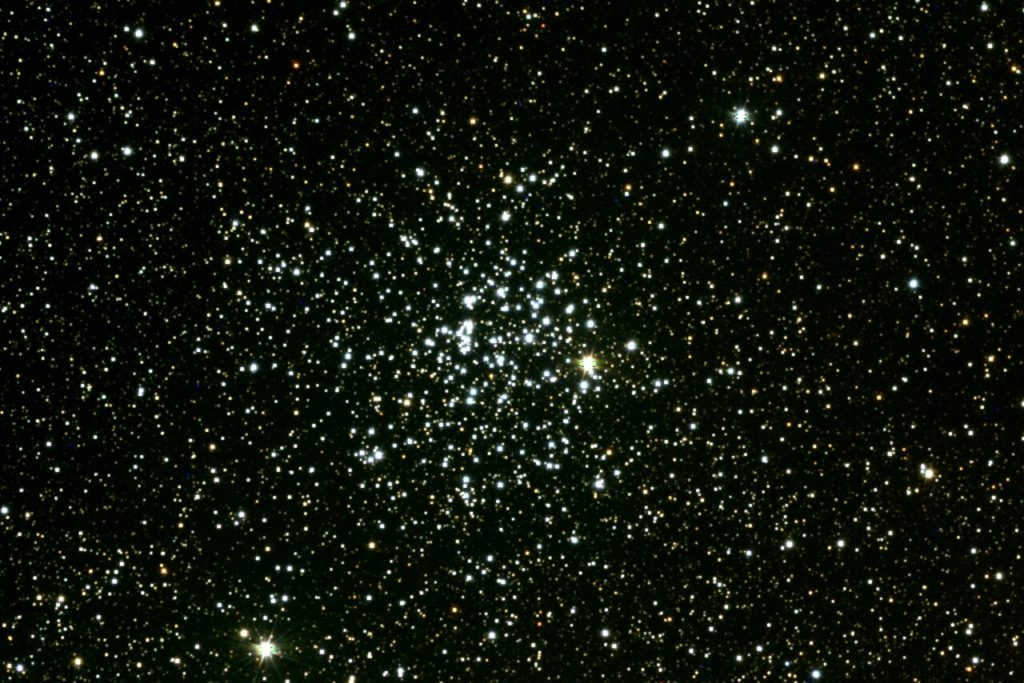
July 1835 saw the first recorded mention of M 52. William Henry Smith described it as an irregular cluster situated to the northwest of the star Kaf. Taking the shape of a triangle, M 52 features an 8th magnitude orange star as one of its vertex points, with the other two vertex points occupied by 7th-8th magnitude stars. Smith also noted a compression in the center of the object, resembling a flame.
M 52 contains approximately two hundred stars. Due to its strong absorption of starlight, the exact distance of M 52 remains unknown. However, estimates place its distance between 3000 and 7000 light years. Messier 52 has an age of 35 million years.
The optimal time to observe this star cluster in the sky is during the autumn season.
NGC 7789.
Even when observed with binoculars, the exquisite and abundant nature of this diffuse cluster leaves a lasting impact. NGC 7789 is comprised of approximately 150 faint stars, yet when seen from a far distance, it gives the illusion of a brilliant 6.7 magnitude star illuminating the heavens. NGC 7789 is occasionally referred to as the Carolina Rose, a title bestowed upon it in honor of Caroline Herschel, the first person to lay eyes upon it.
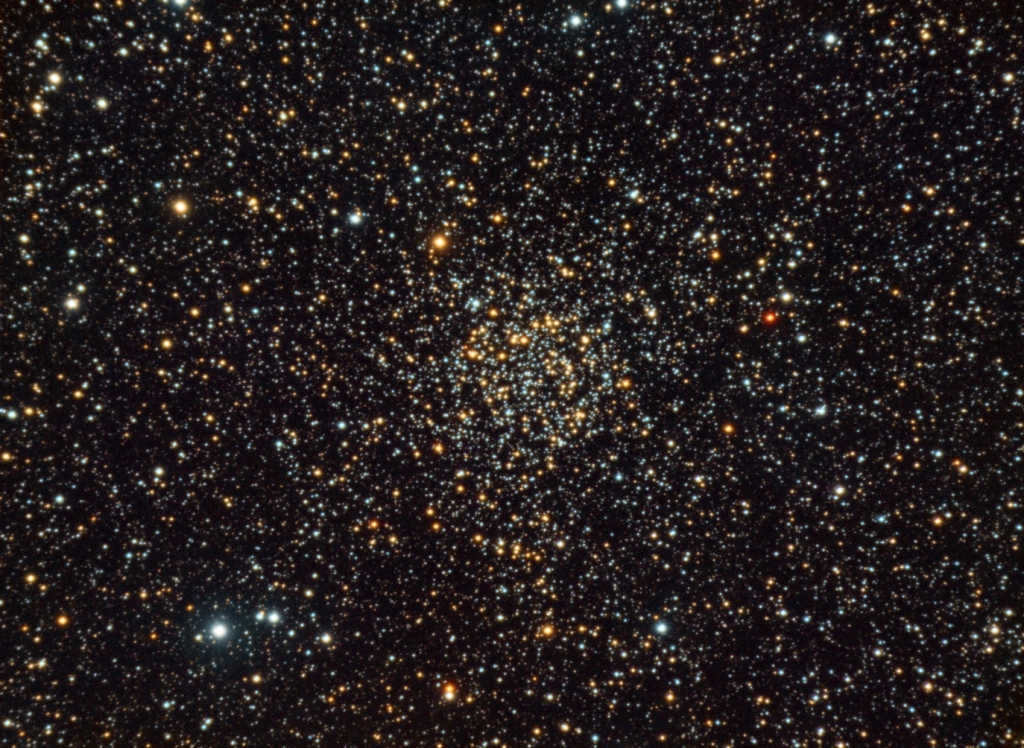
This particular group is situated at a distance of 8000 light-years away from our Sun.
NGC 457
NGC457 is renowned by several monikers such as the “Flying Owl”, “Dragonfly Cluster”, “Airplane”, “Alien”, and various others. It represents a dispersed cluster comprised of variable stars, semi-regular variables, eclipsing doubles, and slowly pulsating stars with stellar magnitudes ranging from 9 to 13.
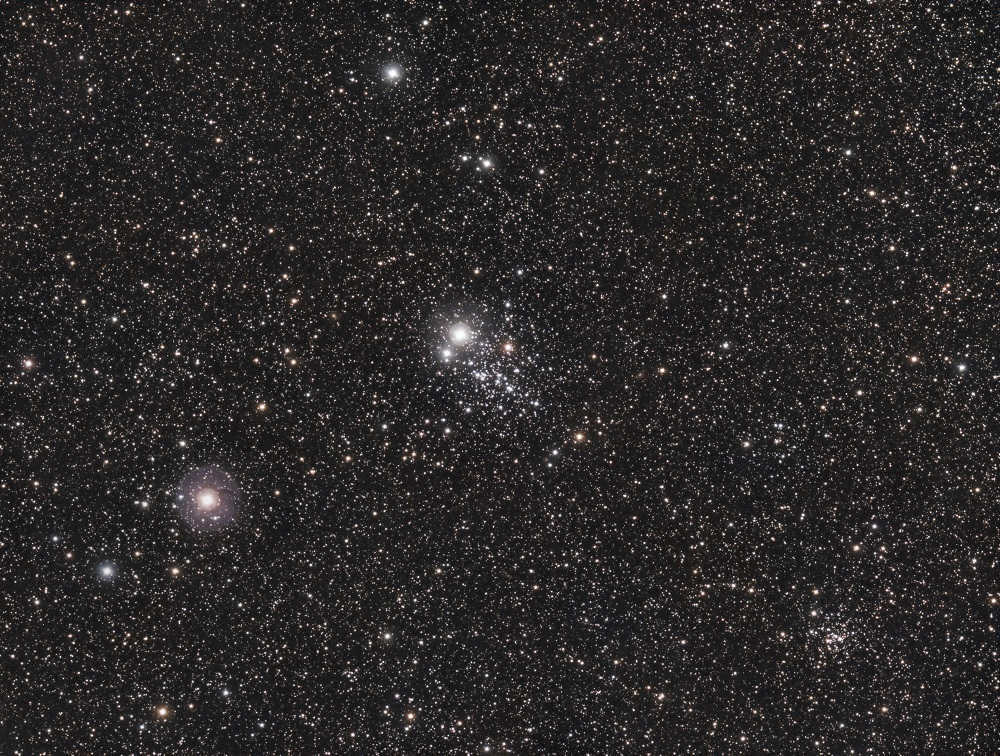
The constellation Cassiopeia contains a variety of fascinating nebulae, such as the diffuse nebula NGC 281, the emission nebula Heart and Soul, the gas nebula Bubble, and the Pakman nebula (NGC 281).
NGC 457, located 7,900 light-years away from the Sun, is estimated to be 21 million years old.
Almost four hundred years ago, a tremendous event occurred in the Milky Way galaxy. The explosion took place over 11,000 light-years away from our solar system, originating from a massive supernova (red giant) that detonated. The resulting blast heated the star’s gas to an astonishing temperature of 30 million °C, causing it to rapidly expand at a velocity exceeding 5000 km/s. In the aftermath of this cataclysmic event, a nebula emerged in the area, stretching an impressive ten light-years in length, with a neutron star positioned at its core. Unfortunately, scientists were unable to directly witness the explosion due to its ancient occurrence, but contemporary telescopes managed to capture the echo of infrared radiation reflected by other nebulae that eventually reached Earth. This awe-inspiring nebula was christened Cassiopeia A and stands as one of the most potent sources of radio emissions, encompassing both infrared and X-rays.
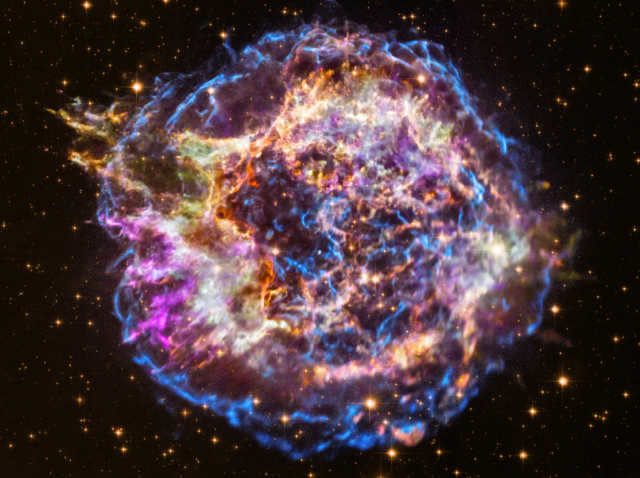
The Bubble Nebula (NGC 7635)
The Bubble Nebula, also known as NGC 7635, is a celestial object located between 7,100 and 11,000 light-years away from Earth. Situated in the same area of the night sky as Messier Nebula 52, this emission nebula was formed by the powerful stellar wind of the star SAO 20575. This star, originally massive and extremely hot, expelled its outer layers, creating a bubble-shaped nebula. With a diameter of 10 light-years and a mass 44 times greater than that of the Sun, the Bubble Nebula shines with a brightness of 8.71 stars. The central star’s rays ionize the surrounding shell, causing the nebula to emit a glowing light.
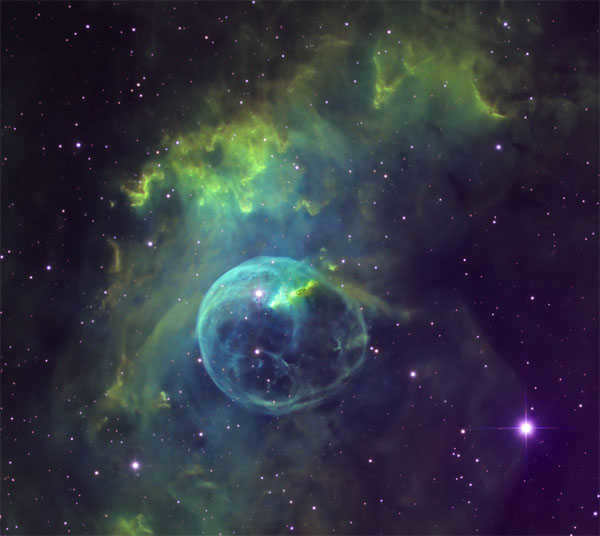
Pakman Nebula (NGC 281)
The nebula got its name because it bears a striking resemblance to the iconic character from the popular computer game. Situated in the constellation Cassiopeia, this celestial entity features distinct formations that resemble a “mouth” and “teeth,” which are actually columns composed of gas and dust. It is within these towering structures that the process of stellar birth is currently taking place.
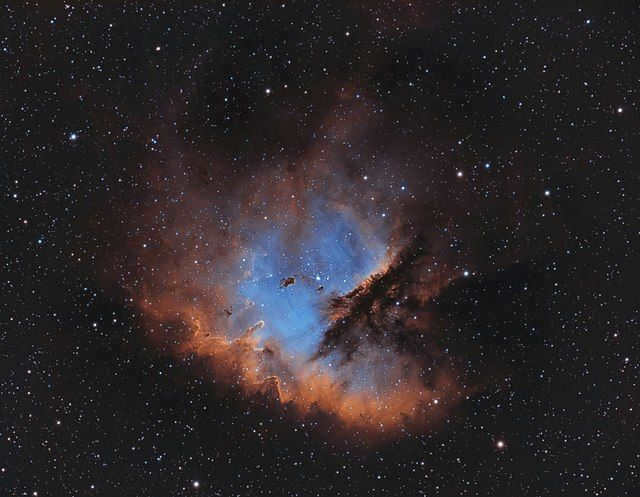
The size of the Cosmic Pacman is quite impressive. Its diameter measures 130 light years. Inside this nebula, there are numerous clusters of young stars, as well as some extremely large and hot stars. Each star is many times larger and more massive than the Sun, and together they emit a powerful stream of ultraviolet radiation.
This nebula is located 10,000 light years away from our planet.
Constellation Cassiopeia’s Galaxies
Within the boundaries of Cassiopeia, there exist various galaxies that possess intricate features. Two dwarf galaxies, namely NGC 185 and NGC 147, deserve particular attention.
NGC 147, a galaxy resembling a compact sphere, was first observed by John Herschel in 1829 and is positioned at a distance of 2.53 million light years away from our planet. This galaxy serves as a companion to the Andromeda Nebula.
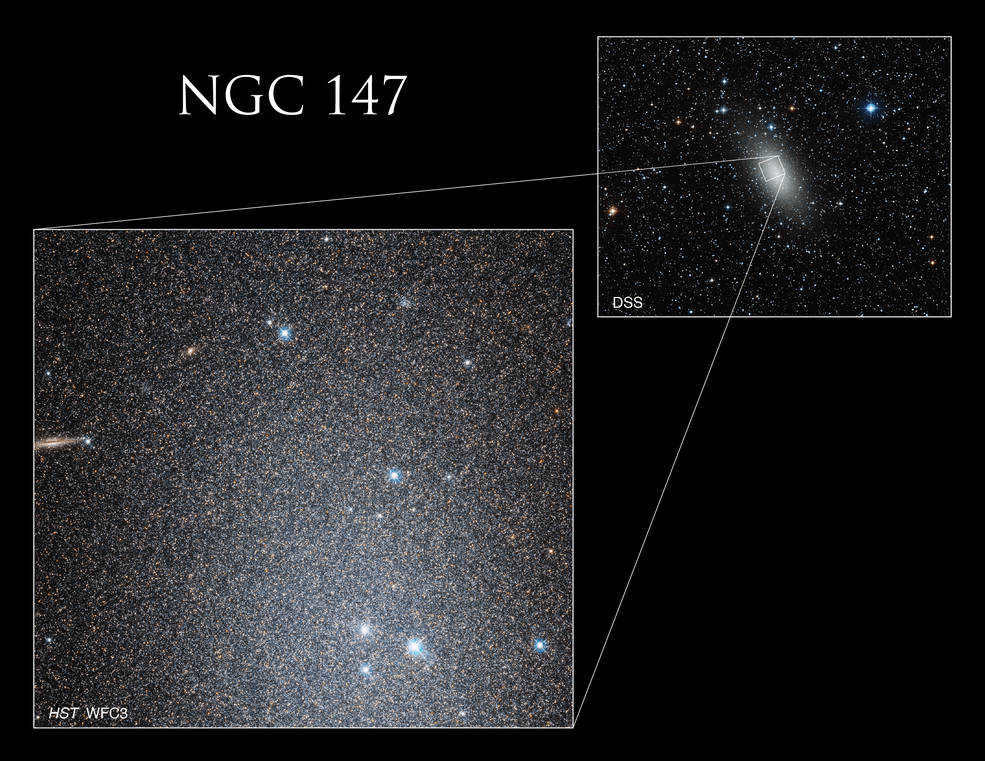
NGC 185 is situated approximately 2.08 million light years away from our solar system. This particular galaxy also serves as a satellite to the Andromeda Nebula. It was identified earlier than NGC 147 and was first observed by the renowned astronomer John Herschel in the year 1787.
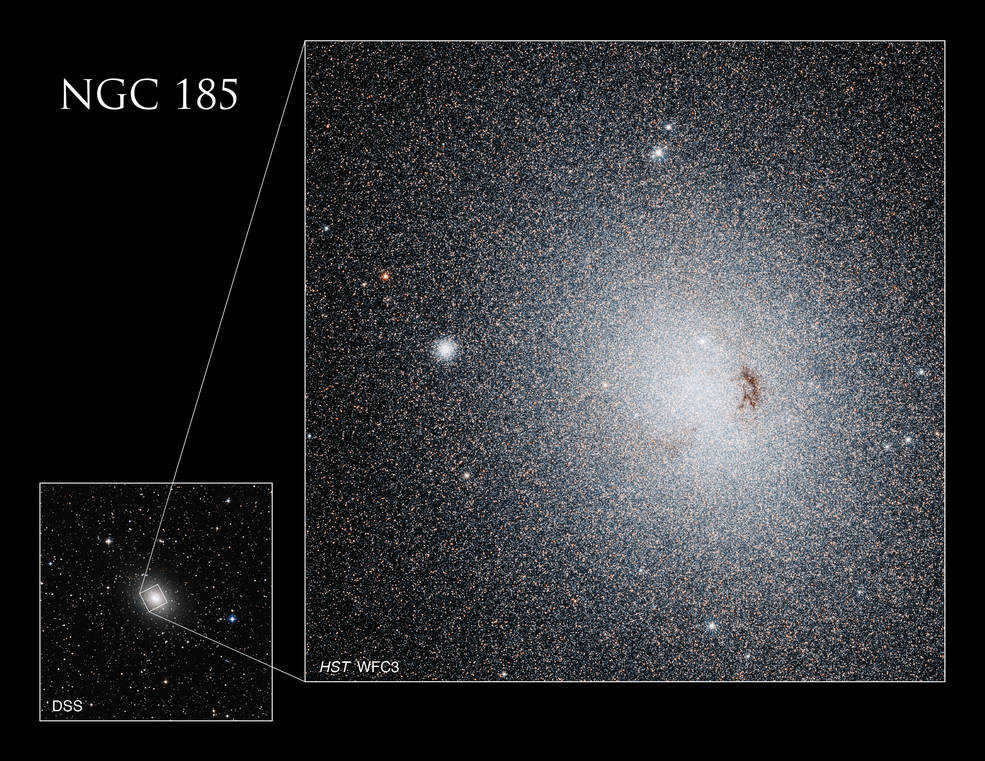
Other celestial objects in the constellation Cassiopeia
Cassiopeia is home to a variety of celestial objects, including star clusters like NGC 436, M 103, NGC 654, and many more.
The mythological significance of the constellation Cassiopeia
Legend has it that Cassiopeia, the wife of Ethiopian king Cepheus, displayed arrogance and pride by claiming to be more beautiful than the nymphs themselves. Offended by this insult, the nymphs sought the punishment of Cassiopeia from Poseidon. The sea king wasted no time and sent the sea monster Cetus to attack the kingdom of Cepheus.
Fearing for his kingdom and his own fate, Cepheus sought guidance from an oracle who advised him to sacrifice his daughter Andromeda. Andromeda was chained to a rock, but she was ultimately saved by Perseus.
Cepheus bestowed his daughter’s hand in marriage upon Perseus. However, an unfortunate incident occurred during the wedding. Perseus clashed with one of Andromeda’s suitors and used the severed head of the Medusa jellyfish to turn him and everyone else who laid eyes upon it into stone, including Cassiopeia and Cepheus.
In a gesture of sympathy towards Cepheus and Cassiopeia, the King of the Sea elevated them to the heavens. Nevertheless, he punished the queen for her arrogance by binding her to the throne. Now, unable to rise from her seat, Cassiopeia spends half of her time suspended upside down.

The region in the sky of the Northern Hemisphere that the site covers is approximately 598.5 square degrees. According to astronomers, there are around 90 bright stars in the constellation Cassiopeia. These stars have a brightness level of 6m or higher, which makes them visible to the naked eye.
A significant portion of the constellation is located within the Milky Way galaxy.
While there may not be a deity responsible for creation, there is a vast cosmos that gives rise to suns, planets, and living beings. There may not be an all-powerful god, but there is a universe that governs the destiny of all celestial bodies and their inhabitants.
K.E. Tsiolkovsky
The Legend of Cassiopeia
In ancient mythology, Cassiopeia was known as the spouse of Cepheus, the ruler of Ethiopia. She boasted of her beauty, even claiming to surpass the enchanting nymphs in allure. This audacious claim provoked the wrath of the nymphs, who sought retribution for Cassiopeia’s arrogance. They beseeched Poseidon, the mighty sea deity, to teach her a lesson. In response, Poseidon unleashed a fearsome creature upon the land of Cepheus, bringing hardship and terror to its inhabitants.
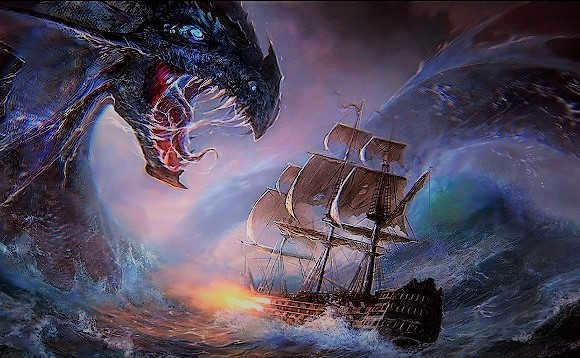
Seeking a solution to protect his kingdom, Cepheus sought guidance from the oracle. His proposal was to offer Princess Andromeda as a sacrifice to Poseidon.
Reluctantly, the king accepted the idea. Andromeda, a breathtaking beauty, was then bound to a rock. However, Perseus, captivated by her charm, came to her rescue. Grateful for his heroism, Cepheus bestowed Andromeda’s hand in marriage upon him. Yet, during the wedding ceremony, a conflict arose between the groom and one of Andromeda’s admirers. Swiftly, Perseus revealed the head of the venomous Gorgon Medusa. The sight of it instantly turned anyone who gazed upon it into stone. Tragically, among the victims were the bride’s own parents.
What is the appearance of the Cassiopeia constellation?
The Cassiopeia constellation is characterized by a distinct figure in the shape of either the letter W or M, created by its bright stars. This unique pattern forms an asterism known as the W-asterism.
Furthermore, Cassiopeia is often depicted as sitting on a throne, with her symbol resembling the queen brushing her hair.
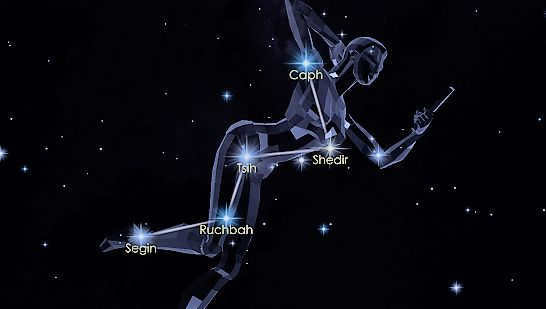
Most luminous stars:
- Alpha Cassiopeia is known as Shedar (α cas);
- Beta is a massive star called Kaf (kaf β cas);
- Gamma is a subdwarf named Navi;
- Delta is a double star system known as Rukbach;
- Epsilon Cassiopeia is a blue-white colored giant named Seguin.;
- Eta is a dwarf star called Achird with a distinct yellow-white color;
- Theta is classified as a blue subgiant, and Hi is a yellow giant;
- Zeta and Kappa are both blue-white in color;
- The constellation also contains Ipsilon-2. Like many others, it has a yellow color and belongs to the giants.

Tycho Brahe, a Danish astronomer, astrologer, and alchemist, made significant contributions to the field of astronomy. One of his notable achievements was the discovery of new stars, including the constellation Cassiopeia. He meticulously compiled a star catalog, recording their precise coordinates.
Furthermore, I would like to highlight a particular star that bears Tycho Brahe’s name. This star was initially identified by the scientist and was subsequently named in his honor. Interestingly, it had a short lifespan as it turned out to be a supernova, a celestial event characterized by a powerful explosion.
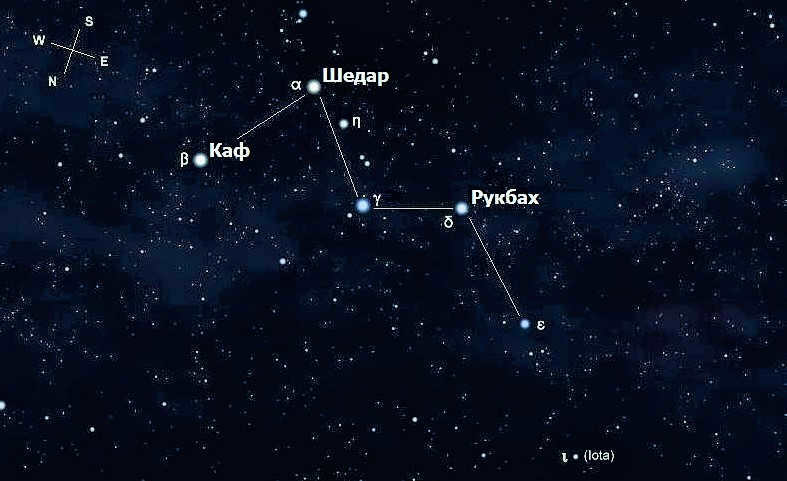
Astronomical entities
By the way, within the constellation lies a remarkable region known as Cassiopeia A, which boasts a potent source of radio emissions.
Additionally, it encompasses numerous dispersed star clusters, namely M 52, M 103, NGC 457, and NGC 7789.
Furthermore, this region is home to the discovery of satellites of the Andromeda Nebula, namely NGC 147 and NGC 185, which are elliptical dwarf galaxies.
Other celestial objects that form part of the Cassiopeia constellation have garnered significant attention. Take, for instance, the diffuse nebula NGC 281, or the equally captivating emission nebulae known as Heart and Soul.
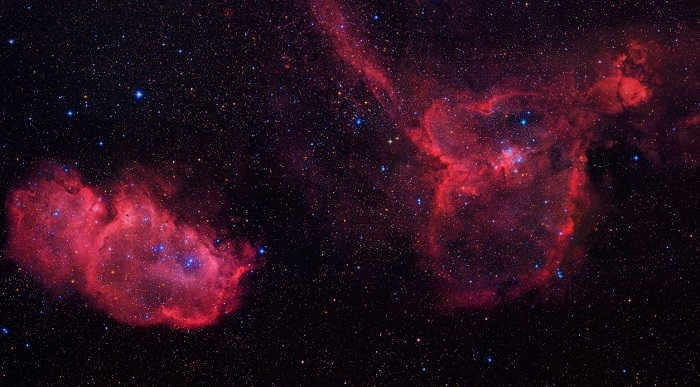
It appears that the constellation Cassiopeia contains a massive gas nebula known as Bubble.
Evidently, every aspect of the area is stunning and scenic.
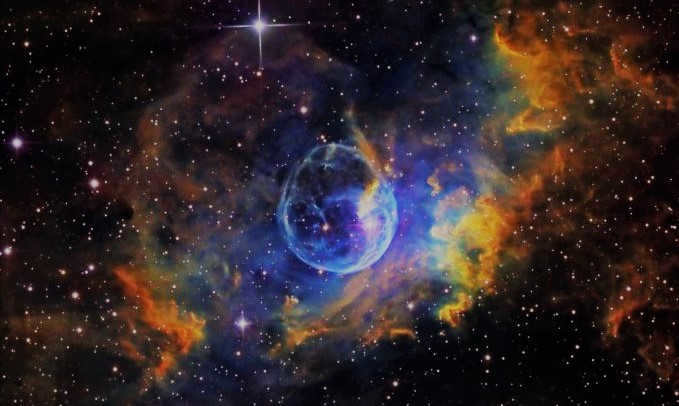
Exploring the Cassiopeia Constellation
We have discovered the appearance of the Cassiopeia constellation. Now, let’s explore how to locate it in the night sky.
It is important to note that Cassiopeia is visible below the horizon during non-sunset hours. However, this observation is specific to Russia. Therefore, it remains consistently visible there.
One could argue that Cassiopeia is the constellation of the autumn sky, as it is best observed during the fall season.
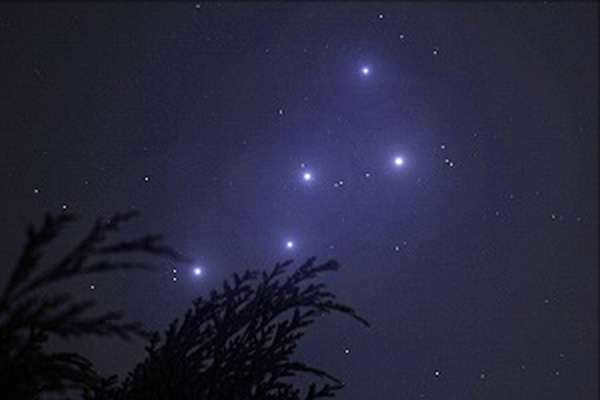
The constellation Cassiopeia holds great significance in the skies of the Northern Hemisphere. For centuries, humanity has been fascinated by the mysteries of the universe, with a keen interest in exploring the celestial objects that adorn the night sky.
When the first clusters of stars were discovered, they were categorized as constellations. These celestial formations were given names based on their resemblance to various figures, including people, animals, and objects. Many constellations were named after heroes from books, fairy tales, and legends.
A captivating tale is presented below for children in grades 1 and 2, as well as older students, about the constellation known as Cassiopeia. This story can be utilized to prepare for a lesson on the world around us, as well as for crafting an essay, report, or outline.
The Mythology of Cassiopeia
In accordance with the ancient Greek myths, Cassiopeia was the spouse of Cepheus, the king of Ethiopia, and together they raised their daughter Andromeda.
Once, Cassiopeia boldly proclaimed that she and her daughter were more beautiful than the sea nymphs known as the Nereids. Despite her otherworldly beauty, the queen possessed an air of haughtiness and arrogance. This audacious act incensed Poseidon, who was married to a sea goddess (one of the Nereids), and he dispatched a sea monster towards Ethiopia. Each day, this monster wreaked havoc and devastation upon the land.
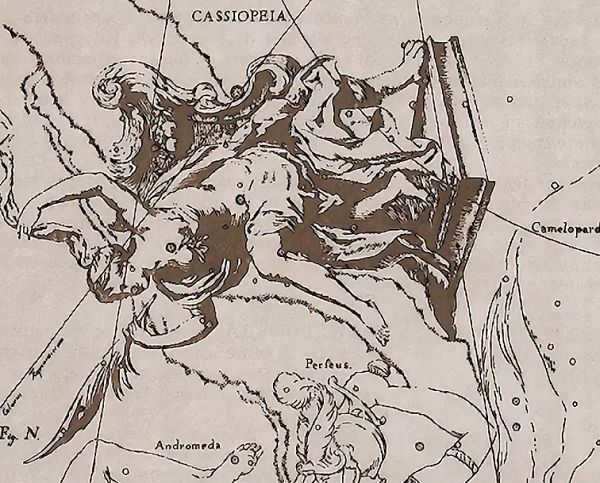
The prophecy from Ethiopia declared that the only solution to eliminate the fearsome dragon was to offer the ruler of Ethiopia’s daughter, the beautiful Andromeda, as a sacrifice.
Cassiopeia and her spouse were reluctant to surrender their cherished daughter, but the weary inhabitants of the land compelled them to accept Poseidon’s terms. The unfortunate girl was bound to a stone where she was left to await her imminent demise. Meanwhile, Perseus soared through the heavens atop his winged steed, Pegasus.
After Perseus beheaded the fearsome dragon Kit (using the sword of Hermes in one version), Andromeda’s parents gladly gave their consent to the marriage. While the wedding preparations were underway, Perseus found himself in a fierce battle against Phineas and his soldiers. During the fight, he managed to kill many enemies, some of whom he transformed into stone by revealing Medusa’s head. Following the wedding, Perseus accompanied his young wife to the island of Seriphos.
Scholars speculate that the myth of Cassiopeia originates from the East, given the resemblance of the names to Eastern names and locations.
Appearance of the Cassiopeia constellation
Similar to the other characters from mythology such as Cepheus, Perseus, and Andromeda, Cassiopeia is a well-known constellation in the night sky. Situated in the Northern Hemisphere, it is comprised of approximately 150 stars that are visible to the naked eye.
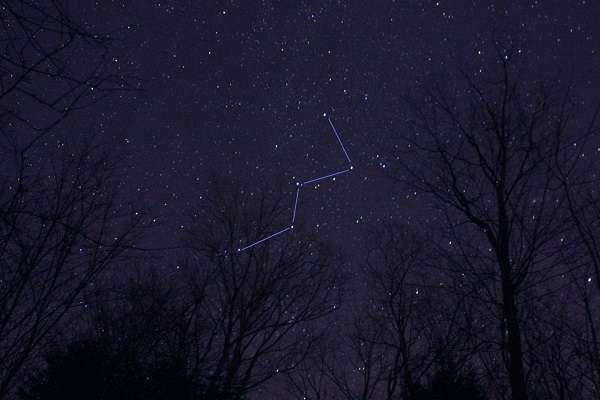
The 5 brightest stars of Cassiopeia have a resemblance to the Latin letter W. Additionally, one can sometimes discern the letter M in these stars.
Schematic representation of the star arrangement in the constellation
Once you stumble upon this star formation, it will always be distinguishable. The group of five stars is also referred to as the Throne, upon which the queen of Ethiopia is poised.
Note: due to its proximity to Polaris, this constellation can be observed throughout the year.
However, it is most easily visible in the autumn season when observing with a telescope, and even the five brightest stars can be spotted in a city sky illuminated by artificial lights.
A visual representation depicting the primary stars of Cassiopeia is provided in the following diagram:
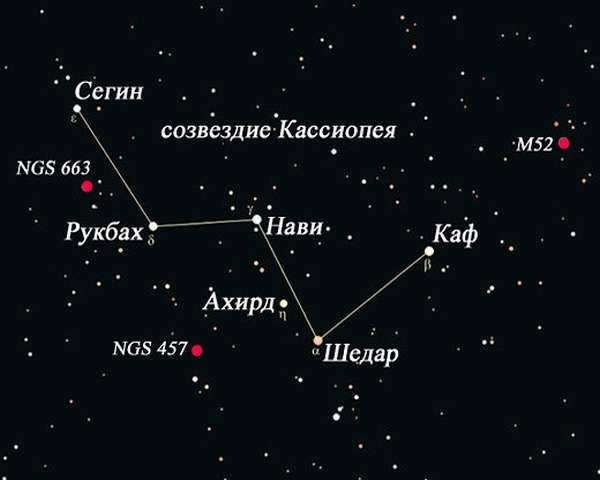
The first star in the constellation, named after a legendary queen from Ethiopia, goes by the name Shedar, which translates to “breast” in Arabic. This specific star is situated right at the heart of Cassiopeia. Kaph represents the second star in this celestial object. Navi is the gamma star of Cassiopeia, Rukbach is the delta star, and Seguin is the epsilon star.
Locating Cassiopeia in the Night Sky
One can easily spot Cassiopeia in the sky near Polaris. In the autumn months, particularly in Moscow’s latitude, it can be observed directly overhead. To get the best view, it is advisable to pick a clear night and venture outside the city.
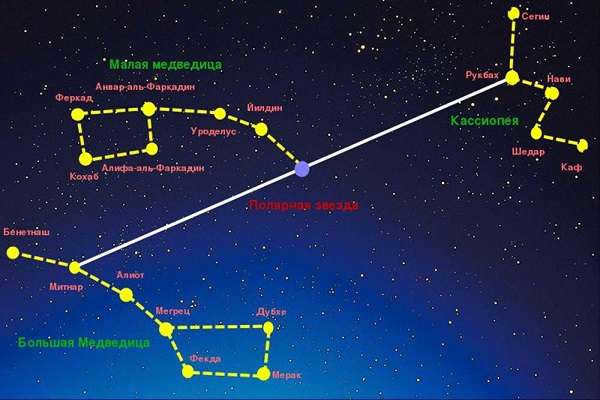
To begin, locate the Big Dipper. Next, mentally connect the edge of the Big Dipper to Polaris, which is part of the Little Dipper.
Then, draw a line from the handle of the Big Dipper to Polaris. With focus and concentration, locating Cassiopeia should prove to be effortless.
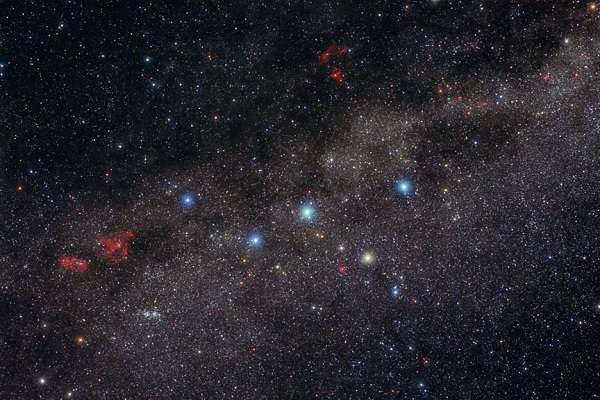
Here are some interesting facts about the constellation that has a fascinating history:
- The majority of the constellation is situated within the Milky Way’s band.
- All of the prominent figures from Greek mythology (Andromeda, Cepheus, Perseus, Pegasus) can be found on the star chart.
- The beta star of the constellation has a mass of 4 solar masses and is 28 times brighter than our own star.
- The brightest star in this grouping is called Navi. It is a variable star that is 40,000 times brighter than the Sun and 15 times its size.
- Cassiopeia was first depicted on Ptolemy’s star map in the 2nd century.
- In 1572, a supernova star named Tycho was discovered in the constellation. It is the most powerful source of radio emission known outside of our solar system. This discovery was made by Tycho Brahe, a Danish astronomer, astrologer, and alchemist.
- This arrangement includes the most potent generator of radio waves.
- In 1973, the film “Moscow-Cassiopeia” premiered, showcasing a storyline about a voyage to the alpha star of the constellation.
- A shrub, bearing bell-shaped white blossoms in the spring or early summer, is named after the celestial entity.

The constellation Cassiopeia can be easily identified in the night sky by anyone, even those who are not familiar with star maps. The brightest stars in this constellation form a distinct letter “W”. However, did you know that there are nearly ninety stars in this constellation? It’s hard to believe!
Were you aware that a supernova exploded in the Cassiopeia constellation during the 16th century? Additionally, can you guess the mistake made by the characters in the movie “Adolescents in the Universe” when they traveled to Alpha Cassiopeia? In this article, we will explore the most fascinating and significant facts about this celestial figure, which was named after… By the way, do you know who it was named after?
The Latin letter “W” is known as an asterism in astronomy.
Identifying the constellation Cassiopeia in the night sky is simpler compared to the Big and Little Bears. The arrangement of five stars forming the shape of the letter “W” is immediately noticeable. This particular pattern is referred to as an asterism within the field of astronomy.
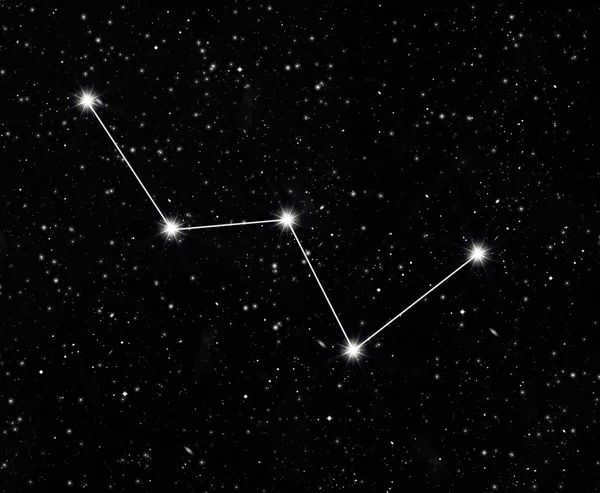
- Can you explain what an asterism is?
This is a collection of celestial bodies that come together to form the most recognizable section of a constellation and have been given their own unique designation on the star map.
For instance, the Big Dipper is an asterism that belongs to the constellation Ursa Major, while Orion’s Belt is an asterism found within the constellation Orion. In the case of the constellation Cassiopeia, this particular group is referred to as the “W asterism” or “W-asterism”.
The W asterism consists of five stars:
| Name | Letter designation in the constellation | Type of star | Radius and mass compared to the Sun | Distance to Earth |
| Seguin | Epsilon of Cassiopeia (ε) | Blue-white giant | Larger than the Sun by a factor of 6, heavier by a factor of 9 | 430 light years |
| Rukbach | Delta of Cassiopeia (δ) | White giant-subgiant, part of a binary star system (the second star is a yellow dwarf) | 4 times larger than the Sun, 3.3 times heavier | 100 light years |
| Navi | Gamma of Cassiopeia (γ). | Variable and optically double star | Larger than the Sun by a factor of 14, heavier by a factor of 19 | 610 light years |
| Shedar | Alpha Cassiopeia (α) | Orange giant (possibly part of a system of two stars, the second of which is a neutron star) | 5 times larger than the Sun, 37 times heavier | 228 light years |
| Kaf | Beta Cassiopeia (β) | Variable star. A subgiant getting ready to become a giant | 3.5 times larger than the Sun, 1.9 times heavier | 47 light-years |
- What is the definition of a variable star? A variable star is a celestial object whose luminosity fluctuates over time, often with significant variations of up to 50% or more.
- How would you describe a double star system? A double star system is comprised of two stars that are gravitationally connected, orbiting around a common center of mass.
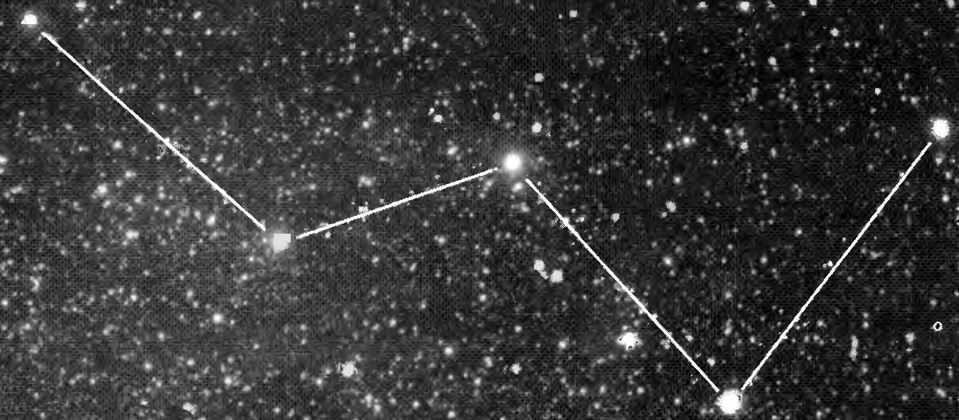
- What is an optically double star? Optically double stars are celestial objects that appear as a binary system to an observer, but in reality, they can be separated by thousands of light years and are not gravitationally connected.
There are also triple and even quadruple optical systems. Interestingly, such phenomena can be found in the Cassiopeia constellation.
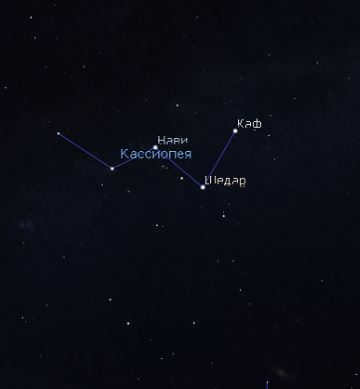
Among the five primary luminaries of the Cassiopeia constellation, one of the most fascinating is its gamma star. What sets it apart is not only its distinctive name, but also its intriguing history. While most star names derive from Arabic origins, such as Kaf meaning “palm” and Sheldar meaning “breast”, Navi stands out as a humorous exception.
This playful moniker was bestowed upon the gamma star of Cassiopeia by American astronaut Virgil Ivan Grissom. Navi is actually a clever reversal of Ivan’s name, with the last letter being replaced. Interestingly, Navi is also an Americanized version of the name Ivan.
Aside from its captivating name, Navi is also notable for being a remarkable variable star. Its brightness fluctuates significantly, with a range of up to 40%! This cycle occurs over a span of fifty years, during which its magnitude can vary from 1.6 to 3.
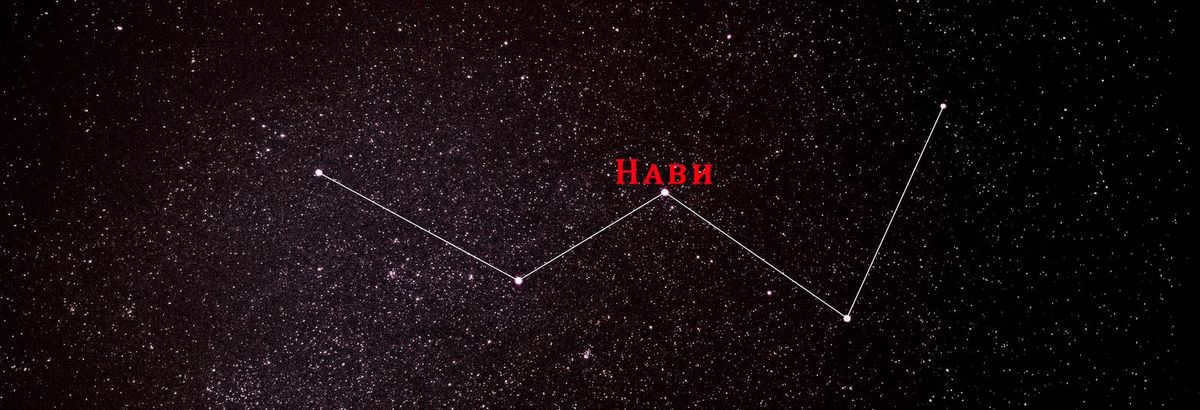
Furthermore, Navi has the ability to unexpectedly erupt in brightness. This occurrence was documented in 1937, where astronomers theorize that Navi experiences periodic powerful explosions, releasing vast amounts of hot gases into the surrounding space.
The radiance emitted by Cassiopeia is so mesmerizing and magnificent that it is likened to “a diamond pin, which Night decorated her kimono” in O. Henry’s tale, “Room in the Attic”.
Not just five stars, but a hundred!
Alpha, beta, gamma, delta, epsilon… Is that all? Definitely not! The Cassiopeia constellation boasts around 90 stars that can be seen from Earth without the need for any telescope or binoculars (provided the weather is clear and one has exceptional eyesight). Within this collection of celestial bodies, there are truly captivating and extraordinary objects.
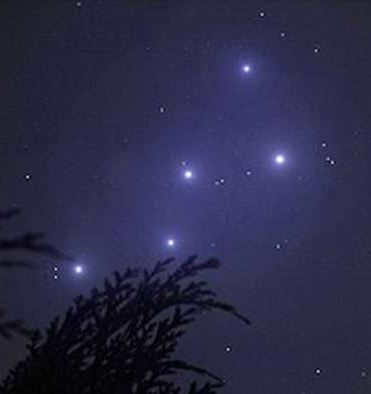
For instance, within the Cassiopeia constellation, there exist:
- myriads of representatives (pulsating variables);
- triple and quadruple optical stars;
- a super-hot Be-star;
- a rotating ellipsoidal variable;
- and even a yellow hypergiant.
What is meant by a rotating ellipsoidal variable?
It refers to a binary star system where the stars are so close to each other that gravity has caused them to transform from spherical shapes to ellipsoids.
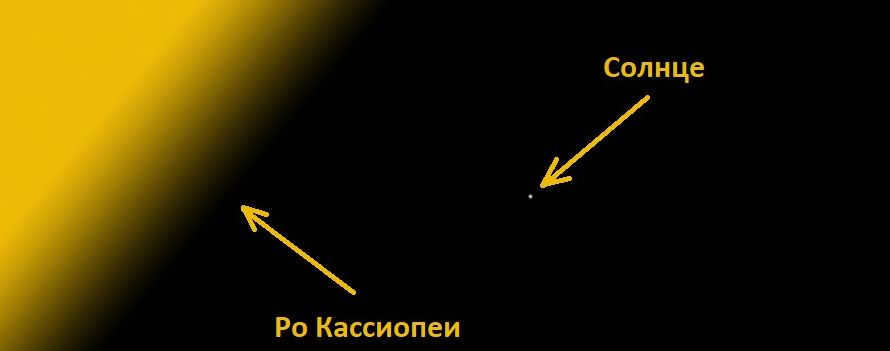
Yellow supergiants are the largest stars. Incredibly enormous! And extremely uncommon. In our galaxy, for instance, there are only seven of them. And one of them resides in the constellation Cassiopeia.
Rho Cassiopeia (ρ), is a star that is 450 times the size of the Sun! This hypergiant has a mass 40 times greater than our Sun, and radiates light that is half a million times more intense (yes, yes, 500,000 times).
But why, you might ask, is it not one of the top five objects in the constellation? Well, that’s because Rho Cassiopeia is located 11,000 to 15,000 light-years away from Earth. It’s so far away that the hypergiant appears as a small, faint star, making it difficult to spot every night.
Astronomers speculate that this star has already undergone a supernova explosion. However, humanity will only be certain of this in a few thousand years.
A star explosion has already occurred in the constellation
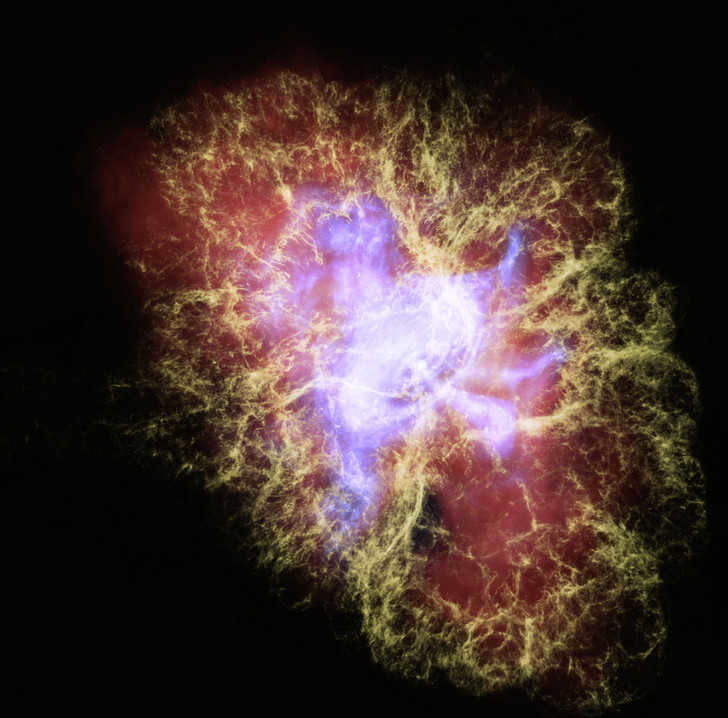
The transformation of Ro Cassiopeia into a supernova is currently only a hypothesis. However, the star SN 1572, which is a part of this constellation, has already undergone a definite transformation into a supernova!
This event occurred approximately 8,000 years ago. However, due to the fact that SN 1572 is located 7,500 light years away from Earth, the flash was only visible to humans in 1572 (hence the name of the object).
This particular supernova lacks an official name, but it is commonly referred to as Tycho Brahe’s star. This renowned astronomer discovered this phenomenon on November 11, 1572 and immediately began to conduct research on it.
“Astounded by the revelation, I was uncertain whether to place trust in my own vision,” penned Tycho Brahe. The celestial body dazzled so brilliantly that it remained discernible even during the midday hours!
It encompasses nebulas
What do the constellation Cassiopeia and the Andromeda Nebula share in common? If you haven’t surmised yet, you’re on the verge of discovering.
Many individuals assume that a constellation merely consists of a congregation of stars observable within a specific region of the firmament. However, astronomers encompass within constellations various other entities – both within our galaxy and beyond. The constellation Cassiopeia incorporates multiple dispersed star clusters, nebulas, and dwarf galaxies.
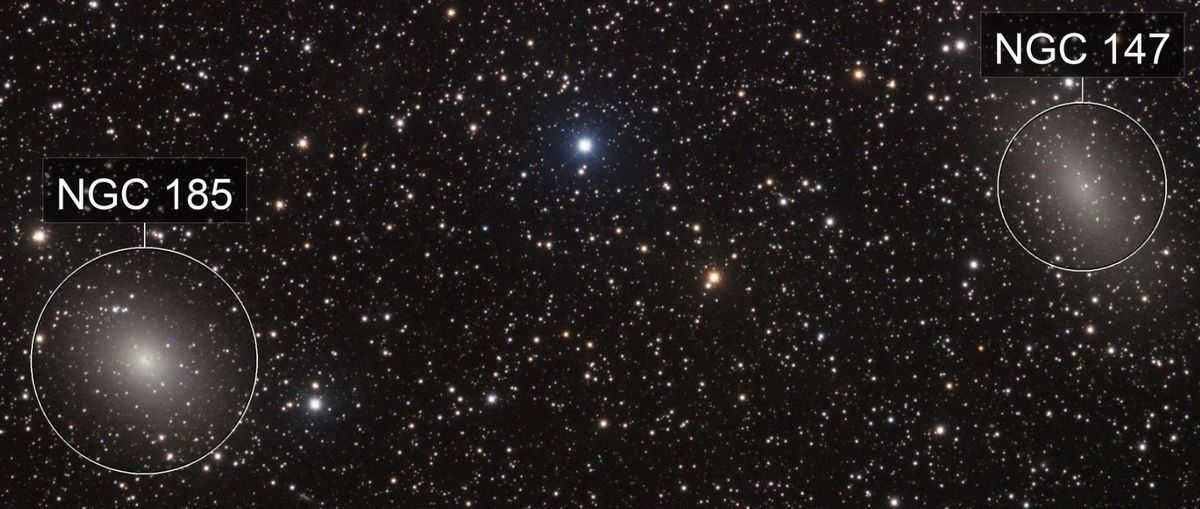
In the constellation, there is another fascinating object known as the Bubble Nebula (NGC 7635). This nebula is created by the stellar wind emanating from the star SAO 20575, which is also a part of Cassiopeia.
Cassiopeia is home to an incredible source of galactic radio emission, which is a highly intriguing phenomenon. This object emits a powerful stream of radio waves, surpassing even the radiation of the supernova Tycho Brahe. Scientists believe that this radio nebula is the remnant of an ancient supernova, possibly caused by the collision of two white dwarfs. Therefore, it wasn’t just one star that exploded, but two simultaneously.
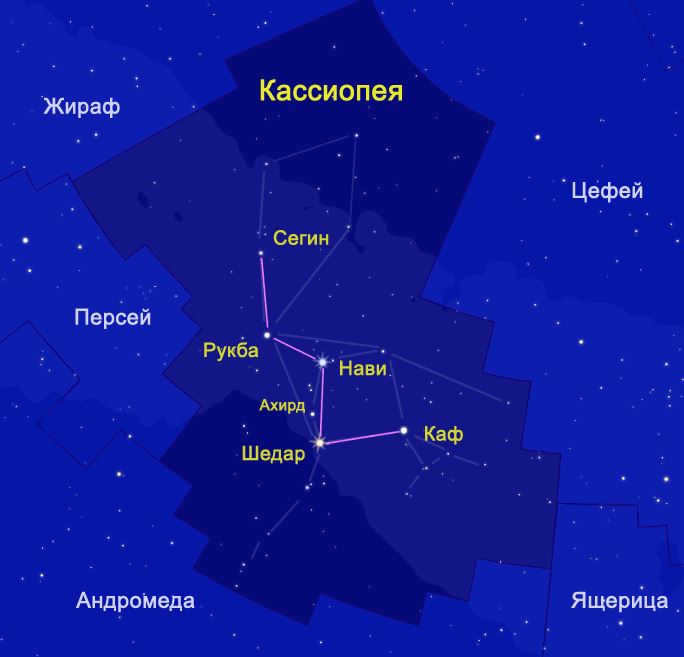
Have you watched the films “Moscow – Cassiopeia” and “Castaways in the Universe”? The protagonists of this duology embarked on a journey to Alpha Cassiopeia – Shedara, which is situated approximately 228 light years away from our planet.
However, it appears that the choice of destination was based solely on the allure of the name: Alpha! The primary star of the most renowned constellation in the entire world. Undeniably captivating, I must admit.
Nevertheless, it would be more fitting to set a course for the star Archid, or more precisely, the binary system of Eta Cassiopeia (η-Achird). It bears a resemblance to the Sun, albeit not as scorching. An orange dwarf orbits in close proximity. This star system is a mere 19.5 light years away from Earth.
If you’re feeling adventurous, you could also embark on a journey to Cassiopeia Mu (μ) system. It’s a fascinating system consisting of a yellow subdwarf star, similar to our own sun, and a red dwarf star that is nearing the end of its life cycle. The distance between our solar system and Cassiopeia Mu is approximately 24.5 light-years.
Alternatively, you can set your sights on stars that have already been found to have exoplanets. Within the constellation of Cassiopeia, there are three such stars: HD 7924, HD 17156, and HD 240210. These stars offer exciting opportunities for further exploration and discovery.
It amounts to less than 1.5% of the celestial expanse
Is it considered diminutive? It would appear so. Merely 1.451% of the vastness of the heavens is occupied by the stars and nebulae comprising this formation. However, it is not actually minuscule. This assemblage of celestial bodies ranks as the 25th largest among the constellations.
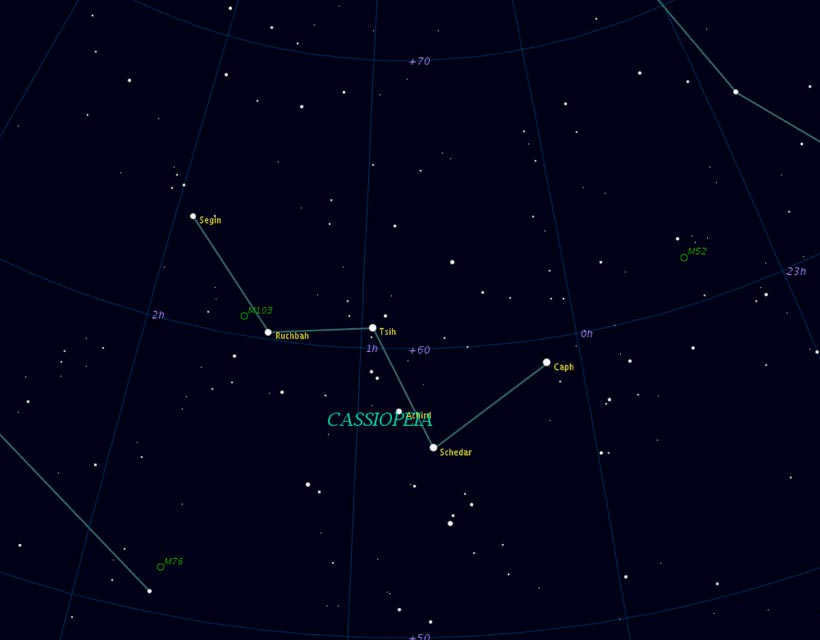
However, what makes the constellation Cassiopeia truly stand out and gain its fame?
- Firstly, the constellation Cassiopeia is renowned for its unique characteristic of almost never going below the horizon and reaching its highest point directly above the observer’s heads.
- Additionally, the asterism W formed by the bright stars in Cassiopeia adds to its popularity and recognizability.
The constellation Cassiopeia is classified as one of the “ancient” constellations, as it is mentioned in the star catalog “Almagest” compiled by the ancient Roman scientist Claudius Ptolemy in 140 AD. This catalog contains the knowledge amassed by astronomers from ancient Greece and the East.
Ancient Greek astronomers identified and named the constellation Cassiopeia, honoring one of the heroines from mythology – the Ethiopian queen who was the mother of Andromeda (who also has her own place on the star map).
Legend has it that Cassiopeia, the wife of King Cepheus, was known for her excessive pride. She would often boast about how her daughter, Andromeda, was more beautiful than any nymph in the entire world, including Amphitrite, the wife of Poseidon, the sea king. As a form of punishment, the gods of Olympus decided to deal with the queen in a rather unique way – they flung her throne directly into the sky, but with a twist… it was turned upside down!
Take a closer look at the letter “W” – can you spot the inverted throne on which the disgraced queen is suspended in the sky?
Queries for responses
The constellation can be observed all year round, but the optimal conditions for viewing are in September to November.
A constellation is an arbitrary pattern that connects the stars visible from Earth, which may appear close together in one region of the sky. However, these celestial bodies can actually be located at significant distances from each other.
It is difficult to provide a definite answer to this question because the idea of a constellation is subjective. The stars comprising the Cassiopeia constellation have varying ages. For instance, Kaf came into existence over a billion years ago, while the “young” Seguin is estimated to be around 15 million years old.
The constellations Cepheus and Andromeda are the nearest neighbors to each other, which is not surprising considering that they are named after the husband and daughter of Queen Cassiopeia. Additionally, the constellations Giraffe and Lizard are also located nearby.
It is unlikely that the star pattern in these systems would be similar to our own solar system. However, it is possible to observe the constellation Cassiopeia from Alpha Centauri, which is not far from our solar system. Interestingly, from the perspective of an observer in Alpha Centauri, our Sun would also be located within the constellation Cassiopeia!





